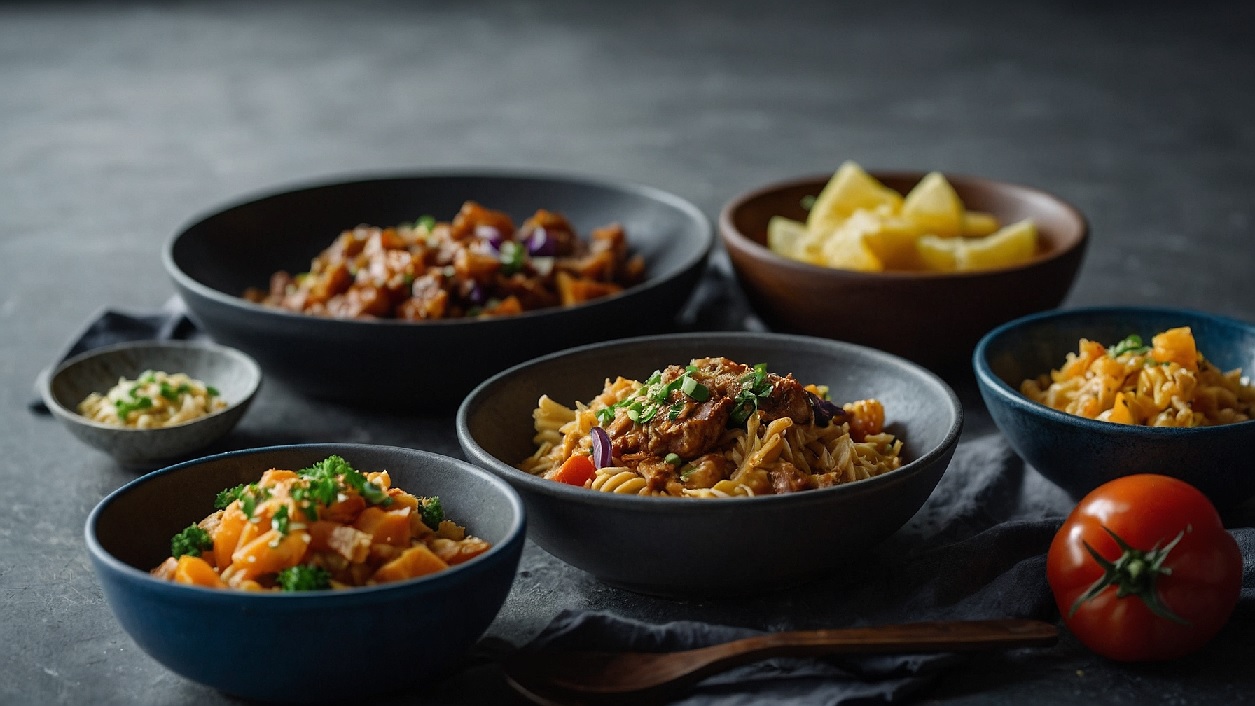Table of Contents
Low-oxalate meals can support kidney health by reducing oxalate levels in your diet. To make these meals, focus on ingredients low in oxalates while ensuring balanced nutrition.
Maintaining kidney health is vital, especially for those prone to kidney stones. High oxalate foods can contribute to stone formation, making it important to manage intake. Creating low-oxalate meals can seem challenging at first, but it becomes easier with the right guidance.
By selecting the right foods and planning your meals carefully, you can enjoy delicious dishes that support your kidneys. In this blog post, you’ll learn how to make tasty, low-oxalate meals that are both nutritious and kind to your kidneys. Let’s dive in and explore how to maintain a kidney-friendly diet without sacrificing flavor.
Benefits Of Low-oxalate Diet

A Low-Oxalate Diet can help support kidney health. Oxalates are found in many foods. They can contribute to kidney stones. By making low-oxalate meals, you can reduce the risk of these stones. This guide will explore the benefits of low-oxalate eating.
Kidney Health
Kidney stones are painful. They can cause serious health issues. Oxalate-rich foods can lead to stones. A low-oxalate diet can prevent kidney stones. Some dietary restrictions can help. Renal diet guidelines suggest limiting oxalates.
Low-oxalate meal ideas include:
- Leafy greens like kale and spinach
- Low-oxalate fruits like apples and grapes
- Lean proteins like chicken and fish
Healthy cooking techniques are important. Steaming and boiling can reduce oxalates. Meal planning for kidney health can be simple. Include kidney-friendly recipes. Avoid foods high in oxalates. Examples are nuts, chocolate, and spinach.
Other Health Benefits
A low-oxalate diet can benefit more than just kidneys. Nutrition for kidney disease is vital. It can also improve overall health. Lowering oxalates can help with digestive health. It can reduce gut irritation.
Additional benefits of low-oxalate eating include:
- Improved bone health
- Better blood sugar levels
- Reduced inflammation
Low-oxalate meals are also good for heart health. They can reduce cardiovascular risks. Healthy cooking techniques can make meals more nutritious. Low-oxalate recipes are often rich in vitamins and minerals. This can lead to better overall wellness.
Key Low-oxalate Foods

Kidney health is very important. One way to help kidneys is by eating low-oxalate meals. Oxalates are found in many foods. They can cause kidney stones. Choosing the right foods can lower oxalates in your diet.
Fruits And Vegetables
Eating fruits and vegetables is good for health. But some have high oxalates. It is best to choose low-oxalate options. Low-oxalate fruits include apples, bananas, cherries, grapes, and watermelon. These fruits are tasty and safe for kidneys. Low-oxalate vegetables include broccoli, cabbage, cauliflower, and cucumbers. They are healthy and help keep oxalate levels low.
Here is a list of low-oxalate fruits and vegetables:
- Apples
- Bananas
- Cherries
- Grapes
- Watermelon
- Broccoli
- Cabbage
- Cauliflower
- Cucumbers
Grains And Proteins
Grains and proteins are important for a balanced diet. Some grains and proteins have high oxalates. Choose low-oxalate grains like rice, corn, and quinoa. These grains are safe for kidneys and provide energy.
Proteins are also crucial. Low-oxalate protein sources include chicken, fish, and eggs. They help build muscles and keep oxalate levels down. Avoid nuts and soy products as they have high oxalates.
Here is a table showing low-oxalate grains and proteins:
| Low-Oxalate Grains | Low-Oxalate Proteins |
|---|---|
| Rice | Chicken |
| Corn | Fish |
| Quinoa | Eggs |
Meal Planning Tips

Making low-oxalate meals is important for kidney health. Oxalate-rich foods can increase the risk of kidney stones. With careful meal planning, you can enjoy tasty, kidney-friendly recipes. Here are some practical tips for making balanced, low-oxalate meals.
Creating A Balanced Plate
Creating a balanced plate is key for nutrition for kidneys. A low-oxalate diet focuses on low-oxalate vegetables, proteins, and grains. Here are some tips to make your plate balanced and healthy:
- Vegetables: Choose low-oxalate options like cauliflower, cucumbers, and lettuce.
- Proteins: Include lean meats like chicken, turkey, and fish.
- Grains: Use white rice, barley, and oats as your grain choices.
Balance your meals by following these dietary guidelines:
| Food Group | Low-Oxalate Options |
|---|---|
| Vegetables | Cauliflower, Cucumbers, Lettuce |
| Proteins | Chicken, Turkey, Fish |
| Grains | White Rice, Barley, Oats |
Incorporate these foods into your meals. This helps maintain kidney health and ensures you’re following the low-oxalate diet.
Also Read: How Do I Use Aquafaba in Vegan Baking?
Shopping List Essentials
Creating a shopping list can simplify meal planning. Here are some essentials for a low-oxalate diet:
- Vegetables: Cauliflower, cucumbers, lettuce, and bell peppers.
- Fruits: Apples, grapes, and peaches.
- Proteins: Chicken breasts, turkey, and fresh fish.
- Grains: White rice, barley, and oats.
Don’t forget these items for your pantry:
- Oils: Olive oil and canola oil.
- Herbs and Spices: Basil, oregano, and garlic powder.
- Other: Low-fat dairy products.
These items will help you create kidney-friendly recipes. Keep your meals interesting and varied by changing the combinations. With these essentials, healthy cooking becomes easier and more effective for kidney health.
Delicious Low-oxalate Recipes
Kidney health is important for overall well-being. Low-oxalate meals can help protect your kidneys and improve your health. Oxalate-rich foods can contribute to kidney stones and other problems. So, choosing low-oxalate recipes is a smart choice. Let’s explore some delicious low-oxalate recipes for breakfast and dinner.
Breakfast Ideas
Starting your day with low-oxalate breakfast recipes can be easy and tasty. Here are a few ideas to get you going:
- Oatmeal with Apples: Cook oats with water. Add chopped apples for sweetness.
- Scrambled Eggs: Use eggs and a bit of milk. Add herbs for flavor.
- Yogurt and Berries: Choose plain yogurt. Mix in strawberries and blueberries.
For those who prefer a warm meal, try this simple recipe:
| Recipe | Ingredients | Instructions |
|---|---|---|
| Veggie Omelette | Eggs, bell peppers, onions, tomatoes | Beat eggs. Cook veggies. Add eggs. Cook until done. |
These breakfast ideas are great for kidney health. They are low in oxalates and full of nutrients. Healthy meal prep can make mornings easier and keep you feeling good.
Dinner Options
Dinner meal ideas that are low in oxalates can be delicious and satisfying. Here are some options:
- Grilled Chicken: Season with herbs. Grill until cooked.
- Steamed Fish: Use lemon and herbs for flavor.
- Roasted Vegetables: Choose low-oxalate veggies like zucchini and bell peppers.
For a complete meal, try this recipe:
| Recipe | Ingredients | Instructions |
|---|---|---|
| Quinoa Salad | Quinoa, cucumber, cherry tomatoes, olive oil | Cook quinoa. Mix with chopped veggies. Add olive oil. |
Low-oxalate cooking can be simple and tasty. These kidney-friendly recipes are perfect for dinner. Enjoy these meals as part of a low-oxalate diet. Nutrition for kidney disease is crucial, and these recipes make it easy to eat well.
Frequently Asked Questions
What Is A Low Oxalate Diet For Kidney Patients?
A low oxalate diet limits foods high in oxalates to reduce kidney stone risk. Avoid spinach, nuts, and chocolate. Eat dairy, and drink plenty of water.
What Meal Ideas Prevent Kidney Stones?
Eat meals rich in calcium, like dairy, to prevent kidney stones. Include fruits, vegetables, and whole grains. Limit sodium, animal protein, and oxalate-rich foods like spinach and nuts. Drink plenty of water.
How Do You Flush Oxalates From Your Kidneys?
Drink plenty of water to help flush oxalates from your kidneys. Include calcium-rich foods to bind oxalates. Limit high-oxalate foods like spinach, nuts, and beets. Maintain a balanced diet to support kidney function. Consult your doctor for personalized advice.
What Foods Dissolve Oxalates?
Foods rich in calcium, magnesium, and potassium can help dissolve oxalates. Examples include dairy products, leafy greens, nuts, and seeds.
Conclusion
Creating low-oxalate meals supports kidney health effectively. Choose fresh, low-oxalate foods. Focus on lean proteins, vegetables, and whole grains. Drink plenty of water daily. Consult with a dietitian for personalized advice. Experiment with recipes to find what you enjoy. Your kidneys will thank you for the care.
Healthy eating, simple cooking, better kidney health.


